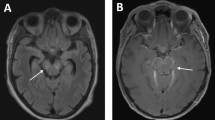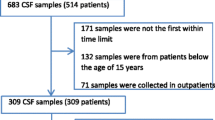Abstract
The purpose of this study was to characterise Lyme meningitis (LM) in a Belgian paediatric population and to suggest findings that could allow early distinction from aseptic meningitis (AM). The medical records of patients hospitalised between 1993 and 2000 and with a discharge diagnosis of LM (n=14) or AM (n=16) were retrospectively reviewed. The Kruskal–Wallis test was used to compare data. Of the patients, 16 were identified with AM and 14 with LM, amongst which 7 presented with isolated LM and 7 with associated peripheral facial palsy (PFP). Patients with AM, when compared with LM, complained of more pronounced signs and symptoms of meningitis (fever, headaches, and neck stiffness); they statistically displayed a shorter period of symptoms before admission (1.6 vs 15 days), higher neutrophilic component (mean 56% vs 2.4%), and lower protein levels (mean 0.39 vs 1.12 g/l) on cerebrospinal fluid analysis. In the neuroborreliosis group, the duration of symptoms was shorter and the cerebrospinal protein level was lower in cases of LM associated with PFP compared to isolated LM (mean 1.3 vs 15 days; mean 0.55 g/l vs 1.12 g/l). Conclusions. Our results suggest that some clinical data and laboratory findings may help the physician to diagnose aseptic or Lyme meningitis before completion of serologic testing. LM should be suspected in cases of meningitis with very low CSF neutrophilic counts and high protein levels associated with prolonged duration of symptoms, low grade fever, and absence of pronounced signs of meningitis.
Similar content being viewed by others
Abbreviations
- LM :
-
Lyme meningitis
- AM :
-
aseptic meningitis
- PFP :
-
peripheral facial palsy
- CSF :
-
cerebrospinal fluid
- WBC :
-
white blood cell
References
Adams WV, Rose CD, Eppes SC, Klein JD (1999) Long-term cognitive effects of Lyme disease in children. Appl Neuropsychol 6:39–45
Albisetti M, Schaer G, Good M, Boltshauser E, Nadal D (1997) Diagnostic value of cerebrospinal fluid examination in children with peripheral facial palsy and suspected Lyme borreliosis. Neurology 49:817–824
Berglund J (1999) Natural history and long-term consequences of Lyme disease in children. Curr Opin Infect Dis 12:265–269
Berglund J, Eitrem R, Ornstein K, Lindberg A, Ringner A, Elmrud H, Carlsson M, Runehagen A, Svanborg C, Norrby A (1995) An epidemiologic study of Lyme disease in Southern Sweden. N Engl J Med 333:1319–1327
Bloom BJ, Wyckoff PM, Meissner HC, Steere AC (1998) Neurocognitive abnormalities in children after classic manifestations of Lyme disease. Pediatr Infect Dis J 17:189–196
CDC (1995) Recommendations for test performance and interpretation from the Second National Conference on Serologic Diagnosis of Lyme Disease. MMWR 44:590–591
Christen HJ, Hanefeld F, Eiffert H, Thomsen R (1993) Epidemiology and clinical manifestations of Lyme borreliosis in childhood: a prospective multicentre study with special regard to neuroborreliosis. Acta Pediatr 82 (suppl 386):1–76
Dotevall L, Hagberg L (1999) Successful oral doxycycline treatment of Lyme Disease-associated facial palsy and meningitis. Clin Infect Dis 28:569–574
Eppes SC, Nelson DK, Lewis LL, Klein JD (1999) Characterization of Lyme meningitis and comparison with viral meningitis in children. Pediatrics 103:957–960
Pachner AR, Steere AC (1985) The triad of neurologic manifestations of Lyme disease: meningitis, cranial neuritis, and radiculoneuritis. Neurology 35:47–53
Robertson J, Guy E, Andrews N, Wilske B, Anda P, Granstrom M, Hauser U, Moosmann Y, Sambri V, Schellekens J, Grav J (2000) An European multicenter study of immunoblotting in serodiagnosis of Lyme borreliosis. J Clin Microbiol 38:2097–2102
Sood SK (1999) Lyme disease. Pediatr Infect Dis J 18:913–925
Steere AC (2001) Lyme disease. N Engl J Med 345:115–125
Steere AC, Berardi VP, Weeks KE, Logigian EL, Ackermann R (1990) Evaluation of the intrathecal antibody response to Borrelia burgdorferi as a diagnostic test for Lyme neuroborreliosis. J Infect Dis 161:1203–1206
Wilke M, Eiffert H, Christen HJ, Hanefeld F (2000) Primarily chronic and cerebrovascular course of Lyme neuroborreliosis: case reports and literature review. Arch Dis Child 83:67–71
Author information
Authors and Affiliations
Corresponding author
Rights and permissions
About this article
Cite this article
Tuerlinckx, D., Bodart, E., Garrino, MG. et al. Clinical data and cerebrospinal fluid findings in Lyme meningitis versus aseptic meningitis. Eur J Pediatr 162, 150–153 (2003). https://doi.org/10.1007/s00431-002-1119-1
Received:
Accepted:
Published:
Issue Date:
DOI: https://doi.org/10.1007/s00431-002-1119-1




